Cathays Park
Cathays Park (Welsh: Parc Cathays) or Cardiff Civic Centre[1] is a civic centre area in the city centre of Cardiff, the capital city of Wales, consisting of a number of early 20th century buildings and a central park area, Alexandra Gardens. It includes Edwardian buildings such as the Temple of Peace, City Hall, the National Museum and Gallery of Wales and several buildings belonging to the Cardiff University campus. It also includes Cardiff Crown Court, the administrative headquarters of the Welsh Government, and the more modern Cardiff Central police station. The Pevsner architectural guide to the historic county of Glamorgan judges Cathays Park to be "the finest civic centre in the British Isles".[2] The area falls within the Cathays electoral ward.
| Cathays Park | |
|---|---|
 Aerial view of Cathays Park | |
| Type | Civic centre |
| Location | Cardiff, Wales |
| Coordinates | 51.4866°N 3.1804°W |
| Created | Early 20th century buildings |
History
Cathays Park was formerly part of Cardiff Castle grounds. The present day character of the area owes much to successive holders of the title the Marquess of Bute, and especially the 3rd Marquess of Bute, an extremely successful and wealthy businessman. They acquired much of the lands in Cathays through investment and by inheritance through a marriage to Charlotte Windsor in 1766.
The idea of acquiring the Cathays House park as an open public space was raised in 1858 and again in 1875. In 1887 it was suggested the park could commemorate Queen Victoria's Golden Jubilee. Negotiations did not begin until 1892, when Lord Bute agreed to sell 38 acres for £120,000[3] (equivalent to £14 million in 2019[4]). The idea of relocating the Town Hall to the park was controversial, but it was also proposed to locate a new University College building there.
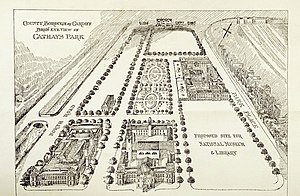
On 14 December 1898, the local council bought the entire 59 acres (24 ha) of land for £161,000 from the Marquess of Bute[3] (equivalent to £18 million in 2019[4]). As part of the sale, the 3rd Marquis of Bute placed strict conditions on how the land was to be developed. The area was to be used for civic, cultural and educational purposes, and the avenues were to be preserved.
A six-month Cardiff Fine Arts, Industrial and Maritime Exhibition which included specially constructed boating lake, a wooden cycling track and an electric railway was held in 1896.[5]
In 1897 a competition was held for a complex comprising Law Courts and a Town Hall, with Alfred Waterhouse, architect of the Natural History Museum in London, as judge. The winners were the firm of Lanchester, Stewart and Rickards, who would later go on to design the Methodist Central Hall in Westminster. These were the first two buildings of the ensemble, and have an almost uniform façade treatment. The east and west pavilions of both façades are identical in design, except for the attic storeys, which are decorated with allegorical sculptural groups. On the Crown Court these are Science and Industry, sculpted by Donald McGill, and Commerce and Industry, by Paul Raphael Montford, while on the City Hall are Music and Poetry by Paul Montford and Unity and Patriotism by Henry Poole.
The third site in this complex went empty until 1910, when the competition for a National Museum of Wales was won by the architects Smith and Brewer. The design parts from the Edwardian Baroque of the Law Courts and City Hall and is more akin to American Beaux-Arts architecture, particularly in the entrance hall where a similarity to McKim, Mead and White's later Metropolitan Museum of Art in New York City has been noted. The Museum site was not bounded to the north by an avenue so there were scarcely any limits on the depth of the building; the 1910 plan was almost twice as deep as it was broad. The First World War, however, ensured that progress on the building was very slow. By 1927 part of the East range, with the lecture theatre funded by William Reardon Smith, was complete. Further extensions came only in the 1960s and 1990s; these remained faithful to the original design on the exterior (and included sculpture by Dhruva Mistry) but are of a neutral character on the inside.
Due to presence of the then Welsh Office building, by the 1990s 'Cathays Park' became used by some as a metonym for that Government Department,[6][7][8][9] and after devolution in 1999, for the Welsh Government's civil servants and ministerial offices.[10][11]
Buildings
| Status | Criteria[12] |
|---|---|
| I | Grade I listed. Building of exceptional interest, sometimes considered to be internationally important |
| II* | Grade II* listed. Particularly important building of more than special interest |
| II | Grade II listed. Building of national importance and special interest |
| Buildings and structures | Listed building status | Architect | Year opened | Image |
|---|---|---|---|---|
| Aberdare Hall | II | W. D. Caröe | 1895 | 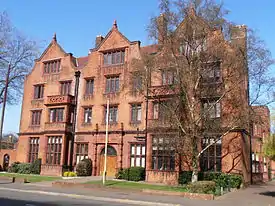 |
| Biosciences and Tower Building | No listing | Dale Owen / Percy Thomas Partnership | 1968 |  |
| Bute Building | II | Percy Thomas and Ivor Jones | 1916 | 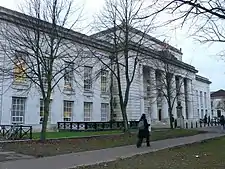 |
| Cardiff Central Police Station | No listing | John Dryburgh | 1968 | 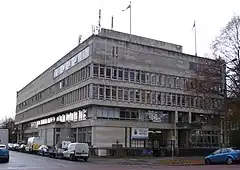 |
| Cardiff Crown Court | I | Lanchester, Stewart and Rickards | 1906 |  |
| Cardiff Law School | No listing | 1963 | 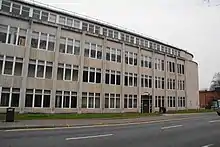 | |
| Cardiff University main building | II* | W. D. Caröe | 1905 |  |
| City Hall | I | Lanchester, Stewart and Rickards | 1906 | 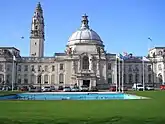 |
| Cathays Park 1 (part of the Crown Buildings complex) |
II | P. K. Hanton | 1938 | 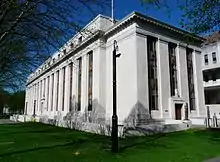 |
| Cathays Park 2 (part of the Crown Buildings complex) |
No listing | Alex Gordon | 1979 | 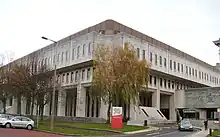 |
| Glamorgan Building (former Glamorgan County Council building) |
I | Vincent Harris and Thomas Anderson Moodie | 1912 | 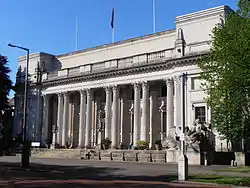 |
| Hut in Gorsedd Gardens | II | Not known | 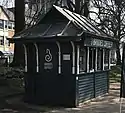 | |
| National Museum and Gallery of Wales | I | Arnold Dunbar Smith and Cecil Brewer | 1927 |  |
| Public conveniences on Museum Avenue | II | Early 20th century |
_geograph-4989804-by-Richard-Sutcliffe_(cropped).jpg.webp) | |
| Redwood Building (Welsh School of Pharmacy) |
No listing | Sir Percy Thomas & Son | 1961 |  |
| Temple of Peace | II | Percy Thomas | 1938 |  |
| University of Wales, Registry | II | H. W. Wills | 1904 |  |
| Welsh National War Memorial | II* | Ninian Comper | 1928 |  |
Gardens
| Cathays Park gardens | |
|---|---|
| Official name | Cathays Park (Alexandra Gardens, Gorsedd Gardens, Friary Gardens)[13][14] |
| Designated | 1 February 2022[13][14] |
| Reference no. | PGW(Gm)26(CDF)[13][14] |
| Listing | Grade II[13][14] |
In addition to the large lawn in front of the City Hall, Cathays Park includes three formal gardens and a tree lined park. Main phases of construction of the gardens were from 1903 to 1906 and from 1924 to 1928.[13] The gardens are grade II on the Register of Parks and Gardens of Special Historic Interest in Wales.[13] All of the spaces are within conservation areas and many of the surrounding buildings are listed. The open spaces are very important to the image of the city. Several important buildings overlook these well kept spaces. Each of the three gardens has its own very different character and each retains its original layout.
Alexandra Gardens
Named after Alexandra of Denmark, the queen consort of Edward VII. The gardens were first called University Gardens, and were laid out and planted in 1903.[13] Alexandra Gardens is 5 acres (2.0 ha) garden located at the heart of the civic centre.[13] It consists of maintained flower beds and grass, with the Welsh National War Memorial standing at its centre.[13] Alexandra Gardens has been protected since September 2019 as a Centenary Fields, which is a Fields in Trust scheme together with the Royal British Legion, which protects green spaces containing a war memorial that honours the memory of the those that lost their lives in World War 1.[15][16]
Gorsedd Gardens
The garden was originally known as Druidical Gardens, but the name Gorsedd Gardens was later adopted. The 2 acres (0.81 ha) garden has as its centrepiece a stone circle constructed in 1899,[13] when the National Eisteddfod of Wales was held in Cardiff. The stones were originally erected elsewhere in Cathays Park for the National Eisteddfod of 1899.[13] They were re-erected in the garden in 1905.[13] The garden's name refers to the Gorsedd of Welsh Bards, the ceremonial order that governs the Eisteddfod. Work on the landscaped gardens began in 1904 and opened to the public in 1910.[13] It is laid out with lawns, and tree and shrub borders and hedges.[13] The gardens has statues of subjects including David Lloyd George and Lord Ninian Crichton-Stuart.
Friary Gardens
The 1 acre (0.40 ha) garden is a style of formal garden formerly known as a Dutch Garden.[13] It was begun in 1904 and completed in 1906.[13] It contains a statue constructed in honour of the 3rd Marquess of Bute by James Pittendrigh Macgillivray and erected in 1928.[13]
Queen Anne Square
Queen Anne Square is a tree-lined grass park, which was built in the 1930s and 1950s. It was designed to be aligned with the main thoroughfare of King Edward VII Avenue, on a site that was originally planned for a Welsh Parliament House.[17] The square is enclosed by a tree-lined no through road, by Corbett Road to the south and by Aberdare Hall to the south east.
Sculpture
| Name | Sculptor | Date | Listed statues status | Image |
|---|---|---|---|---|
| Statue of Third Marquess of Bute | James Pittendrigh Macgillivray | Early 20th century | II |  |
| Statue of John Cory | Goscombe John | 1906 | II |  |
| Statue of Lord Aberdare | Herbert Hampton | 1898 | II |  |
| Statue of Lord Ninian Edward Crichton Stuart | Goscombe John | 1917 | II | 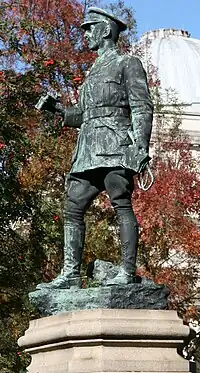 |
| Statue of David Lloyd George | Michael Rizzello | 1960 | II |  |
| Statue of Godfrey, First Viscount Tredegar | Goscombe John | 1909 | II |  |
| Statue of Judge Gwilym Williams of Miskin | Goscombe John | c. 1906 | II | .jpg.webp) |
| South African War Memorial also known as the Boer War Memorial |
Albert Toft | 1909 | II* | _Memorial_2012.jpg.webp) |
| Statue of Girl in Gorsedd Gardens | Robert Thomas | 2005 | No listing |  |
| Three Obliques (Walk In) Sculpture in forecourt of Department of Music, Cardiff University |
Dame Barbara Hepworth | 1968 | II | .jpg.webp) |
| Relief Sculpture on Redwood Building | Edward Bainbridge Copnall | 1961 | No listing | 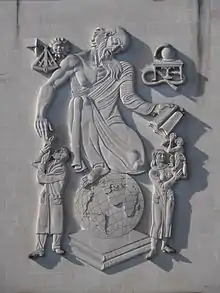 |
Memorial stones
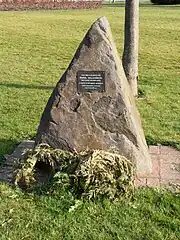 Raoul Wallenberg, a Swedish diplomat who, towards the end of WWII saved the lives of up to 100,000 Jews. Unveiled on 24 November 1985.
Raoul Wallenberg, a Swedish diplomat who, towards the end of WWII saved the lives of up to 100,000 Jews. Unveiled on 24 November 1985..jpg.webp) Cardiff City Falklands Conflict Memorial for the 7 servicemen from Cardiff who died during the Falklands War.
Cardiff City Falklands Conflict Memorial for the 7 servicemen from Cardiff who died during the Falklands War.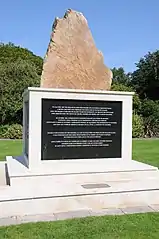 The Welsh National Falklands Conflict Memorial. Unveiled on 30 September 2007
The Welsh National Falklands Conflict Memorial. Unveiled on 30 September 2007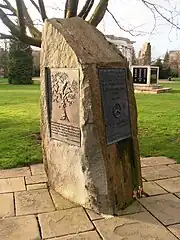 Memorial for those who fought in the International Brigade during the Spanish Civil War, which was unveiled in October 1992.
Memorial for those who fought in the International Brigade during the Spanish Civil War, which was unveiled in October 1992.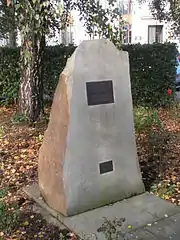 The Gift of Life Stone memorial stone dedicated to organ donors. Erected in 2007 by Kidney Wales.
The Gift of Life Stone memorial stone dedicated to organ donors. Erected in 2007 by Kidney Wales.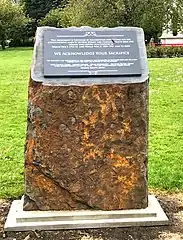
.jpg.webp) Memorial to mark the lives and achievements of Thalidomide impaired people in the UK. Unveiled on 30 June 2016.
Memorial to mark the lives and achievements of Thalidomide impaired people in the UK. Unveiled on 30 June 2016.
Gates, colonnades and obelisks
| Official listed name | Listing status | Image |
|---|---|---|
| University of Wales, Cardiff, including Forecourt Walls | II* |  |
| Colonnade and gateways at south end of Queen Anne Square | II | 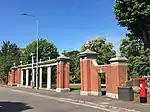 |
| Pair of Obelisk Lamp Stands to west of City Hall Pair of Obelisk Lamp Stands to south west of City Hall Pair of Obelisk Lamp Stands to south east of City Hall |
II | 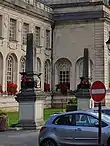 |
References
- Taffy (13 May 2007). "Cardiff Civic Centre – Cathays Park". BIG Cardiff. Retrieved 24 July 2021.
- Newman, John (1995). Glamorgan. The Buildings of Wales. Penguin Books. ISBN 978-0-14-071056-4. p. 220
- Prof. William Rees (1969), "The Reformed Borough, 1836–1914", Cardiff – A History of the City, The Corporation of the City of Cardiff, pp. 336–337
- United Kingdom Gross Domestic Product deflator figures follow the Measuring Worth "consistent series" supplied in Thomas, Ryland; Williamson, Samuel H. (2018). "What Was the U.K. GDP Then?". MeasuringWorth. Retrieved 2 February 2020.
- Brian Lee (30 January 2015). "Cardiff Remembered: When tigers, lions and crocodiles patrolled the city at 1896 exhibition – Wales Online". Retrieved 3 April 2019.
- "Rural Communities in Wales (Hansard, 4 June 1985)". api.parliament.uk. Retrieved 5 October 2019.
- "WALES (Hansard, 22 April 1969)". api.parliament.uk. Retrieved 5 October 2019.
- "Clause 1.—(HIGHER RATES OF NATIONAL HEALTH SERVICE CONTRIBUTIONS AND SUPPLEMENTARY PROVISIONS RELATING THERETO.) (Hansard, 23 February 1961)". api.parliament.uk. Retrieved 5 October 2019.
- "Public Accounts (Hansard, 28 October 1992)". api.parliament.uk. Retrieved 5 October 2019.
- Powys, Betsan (24 May 2011). "The art of delivering delivery". Retrieved 5 October 2019.
- Andrews, Leighton. "Governing Wales – hidden wiring and emerging cultural practice" (PDF). Governing Wales.
- Listed Buildings, English Heritage, archived from the original on 9 December 2012, retrieved 22 April 2011
- Cadw. "Cathays Park (PGW(Gm)26(CDF))". National Historic Assets of Wales. Retrieved 8 June 2022.
- "Cadw/ICOMOS Register of Parks and Gardens of Special Historic Interest in Wales - Cathays Park" (PDF). Royal Commission on the Ancient and Historical Monuments of Wales. Archived from the original (PDF) on 8 June 2022. Retrieved 8 June 2022.
- "Fields We Protect - Alexandra Gardens". Fields in Trust. Retrieved 4 June 2023.
- "Two Cardiff Parks to become protected 'Centenary Fields'". Cardiff Council. Retrieved 4 June 2023.
- "Colonnade and gateways at S end of Queen Anne Square". British Listed Buildings. Retrieved 12 December 2020.
Further reading
- John B. Hilling (2016). The History and Architecture of Cardiff Civic Centre: Black Gold, White City. University of Wales Press. ISBN 978-1-78316-842-2.
- Morley, Ian (June 2009), "Representing a City and Nation: Wales's Matchless Civic Centre", The Welsh History Review, 24 (3): 56–81
External links
![]() Media related to Cathays Park at Wikimedia Commons
Media related to Cathays Park at Wikimedia Commons
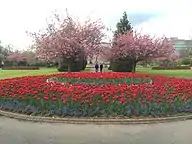
.jpg.webp)
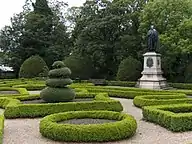
.jpg.webp)

